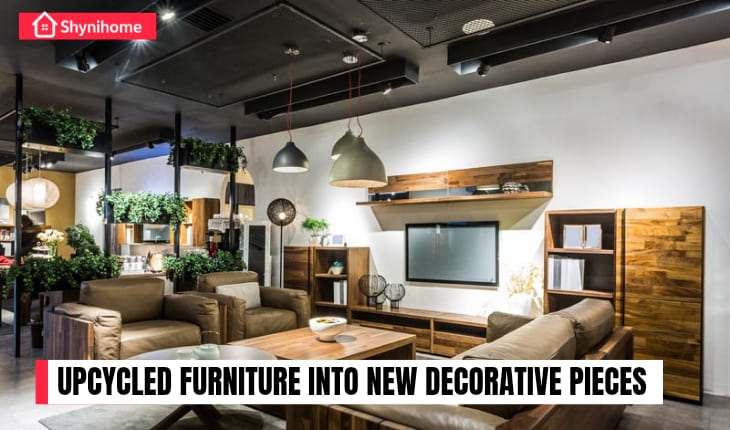
Explore the beauty of Upcycled Furniture with creative ideas to turn old pieces into stunning home decor. Sustainable, stylish, and perfect for any space.
Table of Contents
ToggleIntroduction:
♻️ Give Your Furniture a Second Chance to Shine
Ever looked at an old chair or table and thought, “This still has potential”?
You’re not alone.
Upcycling is all about giving tired, forgotten furniture a fresh, new purpose—without sending it to the landfill.
Unlike recycling, which breaks down materials, upcycling keeps the original form—just with a creative twist.
It turns a dusty dresser into a coffee bar.
Or a broken chair back into a stylish wall hook.
🌱 Why Upcycling Makes Sense (and Feels Good)
Upcycling is more than a weekend project—it’s a mindset.
Here’s why more people are falling in love with it:
- It’s sustainable: You save perfectly usable furniture from the landfill.
- It’s affordable: Why buy new when you can make something amazing for a fraction of the cost?
- It’s personal: Each piece tells your story, in your style.
Imagine walking into your living room and seeing a coffee table you designed from a thrifted trunk.
Now that’s decor with meaning.
🛠️ Anyone Can Start (Yes, Even You)
You don’t need to be a carpenter or artist to start upcycling.
If you can hold a paintbrush, use a screwdriver, and have a bit of curiosity—you’re ready.
This guide will walk you through:
- The best furniture pieces to upcycle
- Tools and materials you’ll need
- Inspiring before-and-after ideas
- How to use chalk paint (no sanding required!)
- Styling and maintenance tips to make your work shine
💡 Ready to See the Possibilities?
Whether you’re a weekend DIYer or a creative soul looking for your next passion project, this guide is here to inspire.
You’ll discover how to turn throwaway furniture into eye-catching decorative pieces that actually serve a purpose in your home.
From chair backs turned into coat hooks to cabinet doors becoming message boards—you’ll find ideas that are easy, stylish, and fulfilling.
So grab that forgotten piece in your garage or check your local thrift shop.
Because we’re about to show you how to breathe new life into the old—with charm, character, and a whole lot of personality.
👉 Also Read: Create a DIY Key Organizer: Keep Entryway Neat & Tidy
What Furniture Is Best for Upcycling Into Decorative Pieces?
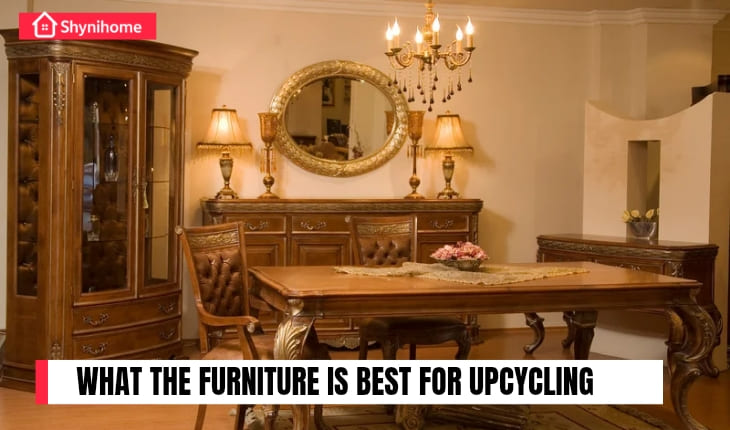
🪑 Start With the Right Piece—Set Yourself Up for Success
Not all furniture is created equal when it comes to upcycling.
Some materials are a dream to work with.
Others? Not so much.
Knowing what to look for can save you time, effort, and a whole lot of frustration.
Let’s break down the best (and trickiest) types of furniture for beginners and experienced DIYers alike.
🌳 Solid Wood: The Gold Standard of Upcycling
If you find a piece made of solid wood, grab it.
It’s strong, forgiving, and holds up well to sanding, painting, staining, or cutting.
Wood pieces—like dressers, tables, or bookshelves—can be easily turned into:
- Wall shelves
- Console tables
- Storage benches
They’re ideal for beginners because they don’t crumble under pressure (literally).
Pro Tip: Flip the piece over to check if it’s really solid wood.
If the grain runs through, it’s solid. If you see a wood veneer or particle underneath, it may not be.
🪵 Cane & Rattan: Lightweight and On-Trend
Cane and rattan are making a big comeback in home decor.
They’re great for creating a light, airy feel in your space.
These materials work well in:
- Boho or natural-style wall decor
- Headboards
- Plant stands or light shelving
They’re not as sturdy as hardwood, but with a little reinforcement, they can become statement pieces.
Caution: Avoid exposing cane to high moisture. It can warp or sag.
🛠️ Metal: Strong, Sleek, and Industrial Chic
Old metal chairs, filing cabinets, or bed frames?
Don’t pass them up.
Metal furniture is durable, often easy to clean, and great for adding an industrial or modern vibe.
Use metal frames to make:
- Towel racks
- Bar carts
- Decorative ladder shelves
⚠️ What About Particleboard and MDF? Proceed with Care
Here’s where many DIYers get stuck.
Yes, you can upcycle particleboard and MDF (Medium-Density Fiberboard), but with limitations.
These materials are made from compressed wood particles or fibers and are not very water-resistant.
✅ Good for:
- Low-traffic decorative pieces (like wall art or accent tables)
- Painting (if properly sealed)
❌ Avoid for:
- Projects that require heavy structural changes (cutting, drilling deeply, or supporting weight)
Pro Tip: Always prime MDF before painting, and avoid over-sanding the edges—it can crumble
🛍️ Where to Find Great Pieces for Upcycling (Even on a Budget)
You don’t need to spend a fortune to find upcyclable furniture.
Here are some go-to sources:
- Thrift stores – Good turnover and pricing
- Garage/yard sales – Negotiate deals for bulk finds
- Facebook Marketplace – Search “Free,” “Curbside,” or “Project” pieces
- Curbside pickups – Keep an eye out during bulk-trash days
Bonus Tip: Look for pieces that are structurally solid—even if they’re scratched or ugly.
Cosmetic damage is fixable. Structural damage? Not so fun.
✅ Quick Inspection Checklist (Don’t Skip This!)
Before you bring a piece home, run through this checklist:
- Stability: Does it wobble? Try shaking it.
- Water damage: Look for soft spots, swelling, or peeling veneer.
- Smell: If it smells like mold or mildew, it might be tough to salvage.
- Hardware: Are hinges, screws, and handles in place or replaceable?
- Surface: Minor chips = okay. Deep cracks or mold = think twice.
💬 In Short…
Start with solid wood for an easy and rewarding upcycle.
Metal, cane, and rattan are amazing too—especially when you want something trendy and light.
MDF and particleboard? Use with care.
The best upcycling projects start with smart furniture choices—ones that are worth the time and creativity you’re going to put in.
Upcycling Furniture for Beginners: What You Really Need
🛠️ Start Simple. Build Confidence. Create Something Beautiful.
If you’re new to upcycling, don’t worry—you don’t need to be a pro to create something amazing.
With just a few basic tools and a clear plan, you can turn old, unwanted furniture into a piece you’re proud to show off.
Let’s walk through everything you need to get started—no overwhelm, no jargon, just the essentials.
🧰 The Must-Have Tools for First-Time Upcyclers
Here’s your beginner’s toolkit. These are easy to find, budget-friendly, and beginner-approved:
- Sandpaper or sanding sponge – For smoothing out surfaces before painting
- Screwdriver – To remove hardware like handles, hinges, or knobs
- Paintbrushes or foam rollers – Use synthetic brushes for water-based paints like chalk paint
- Chalk paint – A favorite for beginners because it sticks well and usually doesn’t require sanding
- Topcoat or sealer – Wax or water-based polyurethane to protect your finished piece
Optional (but helpful):
- Painter’s tape – For clean edges
- Drop cloth – Protect your workspace
- Putty knife and filler – For fixing small holes or dents
🌟 Beginner Projects That Build Skills (and Confidence)
Start with projects that require minimal disassembly and no power tools.
Here are 3 easy ones to try:
- Side Table Makeover
Clean, paint, and swap out the knobs for a quick win. - Drawer Fronts to Wall Hooks
Paint and mount old drawer fronts, then screw in decorative hooks. - Stool to Plant Stand
Shorten the legs, add fresh paint, and voilà—you’ve got stylish greenery support.
These projects teach you the basics: sanding, painting, and finishing—without being overwhelming.
🧤 Safety First: Protect Yourself While You Create
Upcycling is fun—but it still involves tools, chemicals, and sometimes dust.
Here’s how to stay safe:
- Wear gloves when handling old wood or sanding rough edges
- Use a mask or respirator while sanding or painting, especially indoors
- Ventilate your space—open windows or use a fan to keep air flowing
- Avoid working on the floor—use a table or saw-horses to reduce back strain
If you’re working with older furniture, always check for lead paint (especially for pieces made before the 1980s). When in doubt, test kits are available at most hardware stores.
🧭 Your Easy Step-by-Step Workflow
Every successful upcycling project follows the same basic structure:
💬 Final Thoughts: Your First Project Doesn’t Need to Be Perfect
The best part of upcycling? It’s not about perfection.
It’s about creating something new, meaningful, and 100% you.
Start with a small project.
Use the tools you already have.
And don’t be afraid to make mistakes—they’re just part of the process.
Before you know it, you’ll be seeing decorative potential in everything around you.
DIY Upcycled Furniture Ideas That Double as Decorative Masterpieces

🧠 Think Beyond the Basics—Turn Old Pieces Into Eye-Catching Decor
Upcycling isn’t just about saving old furniture—it’s about giving it a second life with purpose.
The best upcycled projects don’t just look good—they function beautifully in your home too.
Below are creative, beginner-friendly furniture makeovers that go beyond the usual paint jobs.
Each one comes with a quick summary, supply list, and pro styling tips to bring your space to life.
🪑 1. Chair Backs as Wall Hooks
From dining room relic to entryway charm
Summary:
Old wooden chair backs can become rustic, functional wall hooks.
Supplies Needed:
- Wooden chair back
- Screws or wall anchors
- Paint or stain (optional)
- Decorative hooks
Styling Tips:
Mount them vertically in entryways or bathrooms.
Paint in pastel tones for a cottagecore look or leave distressed for farmhouse charm.
🧰 2. Old Drawers as Shadow Boxes
Display stories, not clutter
Summary:
Unused drawers can be transformed into deep wall-mounted shelves or memory boxes.
Supplies Needed:
- Wooden drawer
- Mounting brackets
- Scrapbook paper or paint
- Small display items or decor
Styling Tips:
Line the inside with wallpaper or fabric.
Perfect for displaying travel keepsakes, art supplies, or mini plants.
🛏️ 3. Nightstands into Pet Beds
For the fur babies who love vintage too
Summary:
Turn an old nightstand into a cozy bed for your cat or small dog.
Supplies Needed:
- Nightstand (preferably open-shelved or with drawers removed)
- Sandpaper and paint
- Cushion or pillow
- Optional: Wood trim or stencil designs
Styling Tips:
Add your pet’s name with vinyl letters or a wood-burned nameplate.
Place by your bed for a cute and coordinated look.
☕ 4. Coffee Tables into Ottomans
Relax in style with storage underneath
Summary:
Flat-top coffee tables make great bases for upholstered ottomans.
Supplies Needed:
- Coffee table
- Foam padding
- Upholstery fabric
- Staple gun
- Paint (optional)
Styling Tips:
Use bold, textured fabric to make it a centerpiece.
Perfect in living rooms with neutral palettes where the ottoman adds a pop of character.
🖼️ 5. Cabinet Doors as Chalkboards
Stylish and functional for kitchens or kids’ rooms
Summary:
Flat cabinet doors can easily become chalkboards or message boards.
Supplies Needed:
- Old cabinet door
- Chalkboard paint
- Sandpaper
- Hooks (optional, for hanging keys or baskets)
Styling Tips:
Hang in kitchens for grocery lists or in kids’ rooms for fun drawings.
Use vintage handles for extra charm.
🚿 6. Crib Rails into Towel Racks
Give your baby’s crib a second life
Summary:
Crib side rails can be repurposed into vertical or horizontal towel hangers.
Supplies Needed:
- Wooden crib rail
- Mounting brackets or wall anchors
- Paint or finish
- Hooks (optional)
Styling Tips:
Paint white or neutral for a spa feel in the bathroom.
Add S-hooks for hanging baskets or accessories.
🛁 7. Dresser Shells into Bathroom Vanities
Make a statement where it’s least expected
Summary:
Old dressers (minus drawers) can become stylish sink vanities.
Supplies Needed:
- Dresser
- Sink basin
- Plumbing tools
- Paint or finish
- Sealant
Styling Tips:
Look for vintage dressers with strong legs and solid wood.
Seal the top to protect against water damage.
💡 Final Thought: Make Decor That Feels Like You
What makes these projects stand out isn’t just the transformation—it’s the functionality, style, and personal touch they bring into your space.
Each idea here not only saves a piece of furniture from the landfill, but adds warmth, story, and soul to your home.
And the best part?
You don’t have to be a professional—just passionate.
How to Upcycle Furniture with Chalk Paint (Without Sanding!)
🎨 Transform Without the Hassle — Yes, It’s That Easy
Chalk paint has become a DIY favorite, and for good reason—it sticks to almost anything, dries fast, and creates a soft, vintage look with zero stress.
And the best part?
You can skip sanding altogether on many surfaces.
Let’s dive into a beginner’s full guide on using chalk paint—from picking the right finish to pulling off that jaw-dropping before-and-after makeover.
🚫 Why No Sanding? Because Chalk Paint is Made for You
Most paints need a perfectly smooth or primed surface.
Chalk paint doesn’t.
Its formula grips well to wood, metal, laminate, and even plastic—making it ideal for upcyclers who want results without the prep mess.
Still, we’ll cover when a light scuff might help, just to be safe.
🧰 Step-by-Step: Chalk Paint for Absolute Beginners
Here’s a simple workflow anyone can follow—even on your very first project.
1. Wipe It Down
Clean your piece using warm water and mild soap.
No need for harsh chemicals—just get rid of grease and dust.
2. Test a Spot
Especially on glossy finishes or laminate, do a small test patch.
If it peels or doesn’t stick, lightly scuff with sandpaper.
3. Start Painting
Use a round brush or foam roller. Apply thin, even coats.
Let dry for at least 30 minutes between coats.
4. Add a Second Coat (Optional)
Most pieces need 2 coats for full coverage.
Use long, even strokes to reduce streaks.
5. Seal the Surface
Once fully dry, seal with your chosen topcoat (we’ll explain those below).
⚖️ Chalk Paint vs. Traditional Paint: What’s the Difference?
| Feature | Chalk Paint | Traditional Latex Paint |
|---|---|---|
| Surface Prep | Minimal (often no sanding) | Usually needs sanding/priming |
| Finish | Matte, vintage | Glossy to semi-gloss |
| Dry Time | Fast | Slower |
| Tools | Brush, foam roller | Brush, roller, or sprayer |
| Best For | Decorative furniture, vintage looks | Walls, large surfaces |
Chalk paint wins for small projects and character pieces.
But if you want high gloss or ultra-smooth modern finishes, traditional paint might suit better.
🧪 Tips for Best Results on Any Surface
- Laminate or high-gloss? Lightly sand for better adhesion.
- Dark wood? Expect to need 2–3 coats.
- Knots or stains? Use a stain-blocking primer underneath, or the wood might bleed through.
- Humidity? Avoid painting in damp spaces—it slows drying and causes streaking.
💎 Wax vs Matte Sealer: Which Topcoat Should You Choose?
Once painted, your furniture needs protection—especially if it’ll get daily use.
Here are your two best options:
✨ 1. Wax Finish
- Adds a soft sheen and buttery texture
- Best for low-use items (e.g., accent tables, decor pieces)
- Requires reapplication over time
- Apply with a soft cloth or wax brush, then buff
💧 2. Matte Topcoat (Water-Based Poly)
- Durable and moisture-resistant
- Best for high-traffic furniture (e.g., desks, dining chairs)
- Longer-lasting protection
- Dries clear and keeps the matte look
Pro Tip: Want a rustic feel? Go with wax.
Need long-term wear? Poly is your friend.
🔄 Real-Life Mini Makeover: From Tired to Timeless
Project: $10 thrift store side table
Tools: Chalk paint, round brush, wax sealer
Time: 90 minutes start to finish
Result:
A drab, brown table becomes a calming mint green accent piece with vintage vibes. Paired perfectly next to a neutral-toned sofa.
💬 Final Thoughts: Let Chalk Paint Do the Heavy Lifting
Whether you’re flipping a roadside find or refreshing a piece you already own, chalk paint makes the journey simple, fast, and incredibly rewarding.
It’s the perfect gateway into upcycling—no fancy tools, no stress, just color and creativity.
Before-and-After Inspiration: Real Upcycled Transformations
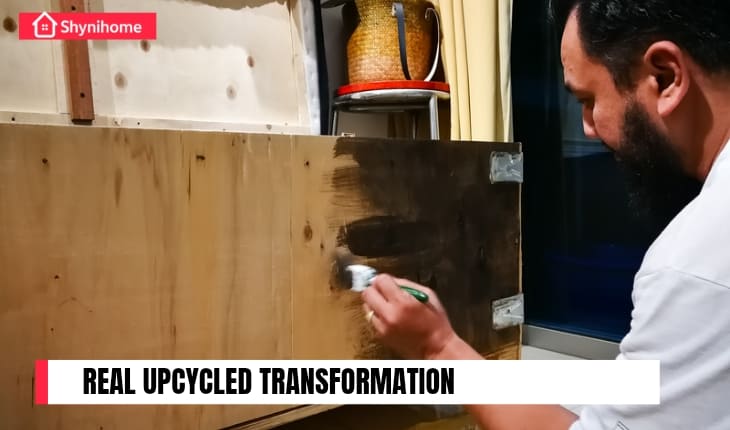
✨ Real Projects. Real People. Real Wow Moments.
There’s something incredibly satisfying about seeing the transformation of old, forgotten furniture into decorative pieces that brighten up a home.
This section brings you real before-and-after stories—each one simple enough to inspire confidence, but impactful enough to spark serious decor envy.
You’ll also get styling tips, a peek into the creative process, and bonus advice for capturing your own upcycled magic.
🪑 Transformation #1: The Forgotten Nightstand Turned Cozy Pet Bed
The Before:
An outdated, scratched-up nightstand with one missing drawer—bought for $5 at a garage sale.
The Process:
- Drawer removed completely
- Sanded the inside lightly
- Painted the outer frame with white chalk paint
- Lined the inside with peel-and-stick wallpaper
- Added a fluffy cushion
The After:
A charming pet bed that looks like it came straight from a boutique store. It’s now a cozy nook for a small dog—and a lovely decorative corner piece in the living room.
Styling Tip: Add a small framed nameplate or paint the pet’s name on the front for an extra cute touch.
🖼️ Transformation #2: Dresser Drawers Turned Decorative Wall Shelves
The Before:
Three shallow drawers salvaged from a broken dresser—dark brown, chipped, and dusty.
The Process:
- Handles removed and holes filled
- Exterior painted in neutral tones (sage green, pale gray, cream)
- Back panel lined with scrap fabric
- Hung on the wall using wall anchors
The After:
A beautiful trio of open wall shelves used to display plants, framed art, and books—perfect for an entryway or reading nook.
Styling Tip: Group shelves in odd numbers (3 or 5) for a naturally balanced, gallery-like look.
☕ Transformation #3: Coffee Table to Ottoman With Hidden Storage
The Before:
A dated glass-top coffee table with scuffed legs and a bulky frame.
The Process:
- Glass top removed and replaced with a padded wood insert
- Fabric tufted over foam to create a soft seat
- Base painted with black satin spray paint
- Hinged top added for storage access inside
The After:
A stylish ottoman with a high-end look and useful storage inside—ideal for hiding remotes, throws, or magazines in small spaces.
Styling Tip: Choose textured fabric in a solid color to match multiple room styles over time.
🧡 Bonus: Reader’s Showcase Corner
Want to be featured in this post?
We’d love to highlight your upcycling story—big or small. Whether it’s a painted side table or a shelf made from scrap wood, your project could inspire others.
Send in your photos with a quick summary of what you did, and we’ll add the best ones to a future feature!
📸 Snap It Like a Pro: Tips for Perfect “After” Photos
Whether you’re posting on Instagram or tracking your progress, your final photos matter.
Use these easy tricks to make your transformations stand out:
- Shoot in natural light – Avoid harsh overhead lights. Use window light in the morning or late afternoon.
- Declutter your background – Let the piece be the star.
- Use a neutral wall or clean backdrop to frame your piece.
- Take shots from eye level and a slight angle for a natural perspective.
- Add props like plants, a rug, or a lamp to show how it fits in a room.
💬 Final Thoughts: Let These Transformations Fuel Your Creativity
Every piece shown here started with someone saying,
“I think I can make something out of this.”
Now it’s your turn.
Look at that scratched-up chair, the forgotten drawer, or the table you’ve been thinking of replacing.
It’s not trash—it’s your next transformation waiting to happen.
Caring for Your Upcycled Furniture
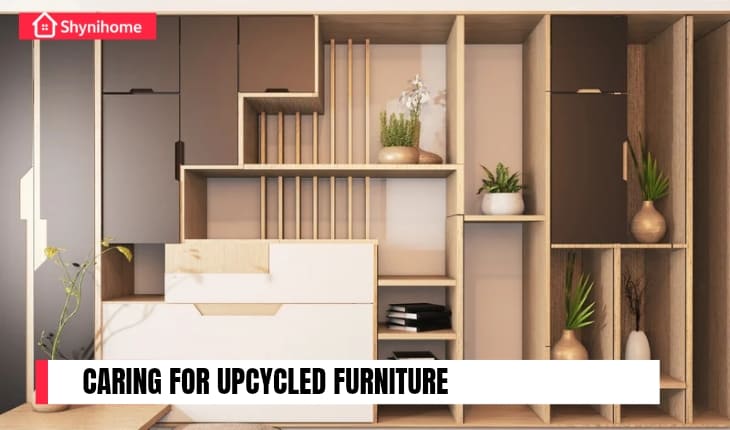
🧼 Love It Longer: Simple Ways to Protect Your Hard Work
You’ve put time, effort, and heart into upcycling that old piece into something stylish and functional.
Now let’s make sure it stays looking just as great.
Whether it’s a chalk-painted dresser, a metal bench, or a varnished shelf, a little routine care goes a long way.
🌳 Caring for Painted Wood: Keep the Charm, Avoid the Chips
Chalk paint and milk paint look dreamy, but they need some TLC.
Do this:
- Dust regularly with a soft microfiber cloth
- Use a slightly damp cloth for cleaning—no soaking
- For chalk paint, apply clear wax or a poly topcoat every 6–12 months for protection
- Add felt pads under decor or vases to avoid scratches
Avoid this:
- Harsh sprays or chemical cleaners
- Dragging heavy objects across the surface
🪵 Varnished Surfaces: Shine and Shield
If your furniture has a varnish or polyurethane finish, it’s already got a durable layer—but it still needs attention.
- Clean with a mild soap solution and dry right after
- Avoid heat or water rings—use coasters and placemats
- Re-coat with varnish every couple of years if you notice dulling or scratches
🔧 Touch-Up Tricks for Everyday Accidents
Even with care, life happens. Here’s how to fix common issues fast:
- Tiny chips or dings? Dab on matching paint with a small brush or Q-tip
- Water marks or rings? Try gently rubbing with baking soda and water paste
- Scratches on wood? Use a crayon or touch-up pen in a matching tone
Keep a small “touch-up kit” with leftover paint, wax, and brushes on hand. It saves you time and stress later.
💪 Keep It Fresh for the Long Haul
Here are a few pro habits to extend the life of your upcycled furniture:
- Rotate decor items to avoid wear spots
- Avoid direct sunlight to prevent fading—especially with darker colors
- Keep the piece away from humidity if it’s made of wood or MDF
- Refresh wax or topcoat every 6–12 months
Bonus Tip: Snap a quick photo of the back or underside of the furniture with a list of materials used (paint type, finish, etc.)—this makes future touch-ups or resales easier.
💬 Final Word: Respect the Work, Enjoy the Beauty
Taking care of your upcycled furniture isn’t a chore—it’s an act of respect for the time, love, and creativity you’ve poured into it.
With just a few thoughtful steps, your DIY masterpiece will keep shining and serving its purpose for years to come.
Styling and Integrating Upcycled Pieces into Your Home
✨ Give Your Upcycled Furniture a Place to Shine
Upcycled furniture isn’t just about saving money or being eco-conscious.
It’s about adding soul to your space.
These unique pieces can bring warmth, character, and even conversation to your home—if styled thoughtfully.
Let’s explore how to make your creations blend seamlessly into different rooms and styles.
🛋️ Living Room: Let It Be the Star
Your living room is the heart of your home. It’s the perfect place to show off an upcycled statement piece.
Try these ideas:
- A repainted dresser as a media console
- An old coffee table turned ottoman with new fabric
- A ladder-style shelf from reclaimed wood as a book display
Style tip: Pair old wood with modern elements like a glass vase or a sleek lamp for a balanced look.
🚪 Entryway: Make an Entrance That Wows
Even small spaces deserve personality.
Try using:
- A vintage bench with new paint and cushions
- An old side table as a key-drop spot
- A refinished mirror frame for a functional focal point
Style tip: Add hooks or baskets for both charm and functionality.
🧑💼 Home Office: Creativity Meets Comfort
Upcycled pieces can transform a bland workspace into an inspiring zone.
Try:
- Turning a vintage desk into your creative command center
- Using old drawers as floating shelves
- Adding a painted chair with bold fabric for a pop of personality
Style tip: Mix in greenery and soft lighting to avoid a cluttered feel.
🛏️ Bedroom & Beyond: Soft Looks, Strong Personality
In bedrooms, subtle upcycled accents work best:
- Use a repurposed nightstand with distressed paint
- Hang upcycled cabinet doors as headboards
- Place a painted trunk at the foot of the bed for both storage and charm
🖼️ [Insert Image: Bedroom corner with soft-toned upcycled side table and lamp]
Caption: Vintage touches bring warmth and individuality to restful spaces.
🎨 Blending Styles Without the Clash
Worried that an old piece won’t match your aesthetic?
Here’s the secret: contrast creates interest.
- Pair rustic wood with modern black accents
- Combine vintage lines with minimal color schemes
- Mix textures: wicker, metal, chalk-painted wood, glass
🍂 Seasonal Decor Refresh: Keep It Fresh All Year
Give your upcycled furniture a seasonal touch without overdoing it:
- Spring: add light fabrics, greenery, and florals
- Summer: use coastal colors like white, teal, or driftwood tones
- Fall: layer with warm textures like throws, pumpkins, or amber glass
- Winter: go cozy with candles, fairy lights, and rustic elements
🏁 Final Thought: Don’t Just Decorate—Curate
Each upcycled piece carries a past—and now a new chapter in your home.
With just a few thoughtful styling choices, you can make any old item feel like it was always meant to be there.
Common Upcycling Mistakes to Avoid
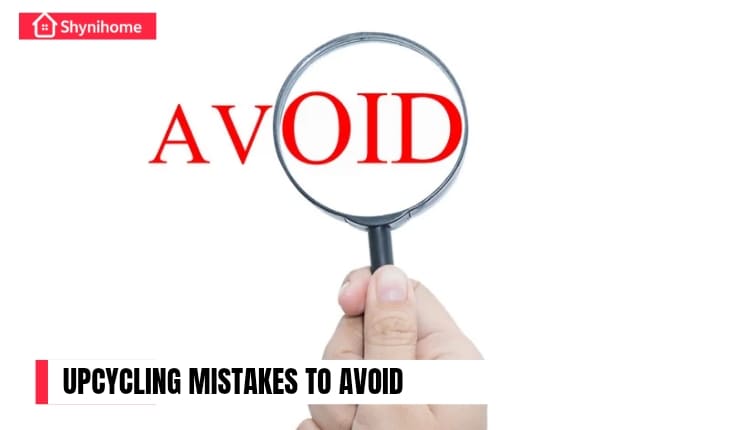
⚠️ Learn from These Mistakes—So You Don’t Make Them
Upcycling is a fun, creative, and rewarding process—but like anything hands-on, mistakes can happen.
The good news? Most of them are easy to avoid once you know what to watch out for.
Here are the most common pitfalls that beginners (and even seasoned DIYers) sometimes fall into—and how you can sidestep them gracefully.
❌ 1. Overworking or Damaging Antique Pieces
Sometimes, a piece isn’t meant to be totally transformed.
Before painting or sanding that old dresser or table, ask yourself:
“Is this vintage, or is it valuable?”
Antiques may have historical or collector’s value that could be lost with heavy changes. If in doubt, look up the manufacturer or markings—or ask in online vintage communities.
Instead of full upcycles, consider:
- Replacing knobs only
- Adding a lining to drawers
- Refreshing gently with beeswax or natural polish
🛠️ 2. Skipping the Prep Work
This is one of the biggest mistakes in DIY furniture flipping.
You might be excited to dive in with a brush, but taking time to clean, sand, and inspect your piece first will save you a lot of frustration later.
What to always do before painting:
- Clean thoroughly (especially grease spots)
- Lightly sand for better paint grip (unless using no-sand chalk paint)
- Tighten or replace hardware and fix loose joints
🎨 3. Using the Wrong Tools or Finishes
Not all paints and sealants are created equal.
For example:
- Latex paint might chip easily on furniture
- Some waxes are hard to apply evenly
- Oil-based paints offer durability, but take much longer to dry and need ventilation
Tip: Chalk paint is beginner-friendly, but always seal it with a topcoat or wax to prevent wear.
Also: use good-quality brushes or foam rollers to avoid visible streaks or lint.
🖼️ 4. Ignoring Design Harmony in the Room
It’s easy to get so focused on making a piece “pop” that you forget about the space around it.
If your upcycled furniture clashes with the rest of the room, it may feel out of place instead of special.
Here’s how to avoid that:
- Choose colors that complement your existing decor
- Repeat similar textures or finishes elsewhere in the room
- Think about scale—a bold item needs breathing room
Styling tip: Tie in your upcycled piece with matching cushions, rugs, or wall art.
🧠 5. When to Preserve vs. When to Upcycle
Here’s a thoughtful question that often gets skipped in other blogs:
How do you know when to transform—and when to treasure?
Use this quick test:
- Is it structurally sound but uninspiring? → Upcycle!
- Is it damaged beyond repair? → Break it into smaller projects
- Is it valuable or rare? → Consider preservation
It’s okay to leave something as-is—or just refresh it slightly. Upcycling doesn’t always mean dramatic changes.
✅ Final Takeaway: Thoughtfulness Wins
The best upcycling projects come from care, creativity, and a little planning.
By avoiding these common mistakes, you’ll not only save time and money—you’ll create a piece that’s built to last and loved for years.
👉 Also Read: DIY Projects for Beginners: Build, Create & Upgrade Your Home
Conclusion:
✨ You’re Not Just Saving Furniture—You’re Creating Magic
Upcycling isn’t just a fun DIY trend.
It’s a creative lifestyle that blends sustainability, style, and self-expression.
With every chair, drawer, or cabinet you give new life to, you’re:
- Reducing waste
- Saving money
- And adding personal flair to your home
And the best part? You don’t need to be a pro to get started.
🛠️ Start Small, Dream Big
Don’t worry about transforming a whole room on day one.
Begin with something easy:
- A wooden tray into a key holder
- An old chair into a plant stand
- Or even just repainting a shelf
Each small project builds your confidence—and your style.
The more you do, the more you’ll learn what works, what doesn’t, and what feels uniquely you.
🌱 Your Creative Journey Starts This Weekend
If you’ve been waiting for a sign—this is it.
Pick a small piece.
Gather your tools.
And get started this weekend.
Your future self will thank you.
And when you do?
We’d love to see it.
📸 Tag and Share Your Masterpiece
Once your project is done, take a photo of your transformation!
- Share it on Instagram or Pinterest
- Tag us and use the hashtag #UpcycleGlow (or your brand’s tag)
- You might even get featured in a future post or newsletter!
Let your creativity inspire others to jump in.
Because this movement isn’t just about furniture—it’s about giving things (and yourself) a second chance to shine.
